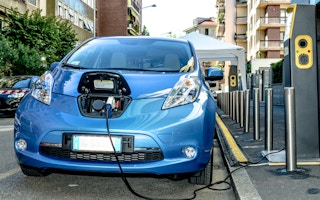The world entered a new era of transportation history in December 2012, when the number of vehicles on the roads reached an unprecedented level of over 1 billion globally. There is no sign of slowdown, with more than 65 million new vehicles produced in 2013 alone, and the total number of vehicles on the road is expected to hit 1.7 billion by 2035, with growth stemming from China.
To continue reading, subscribe to Eco‑Business.
There's something for everyone. We offer a range of subscription plans.
- Access our stories and receive our Insights Weekly newsletter with the free EB Member plan.
- Unlock unlimited access to our content and archive with EB Circle.
- Publish your content with EB Premium.
These figures may represent a notable success story – propelling economic growth for certain nations – but, there is a downside. Almost 98 per cent of all vehicles still run on oil. This means that “transport oil addiction” is worsening with transport energy usage doubling over the last thirty years, placing additional pressure on the global oil supply chain each year, with no certainty on how long supply can keep up with demand. Korea, for example, spends about 100 billion USD a year on oil import, five times more as compared to ten years ago. This becomes a strain on the country’s expenditure, and is a problem stretching globally from Asia to Europe.
At the same time, in order to meet the 2°C temperature increase limit set by the Intergovernmental Panel on Climate Change (IPCC), efforts are made globally to rapidly reduce the level of greenhouse gas emissions. Additionally, the limit of carbon dioxide in the atmosphere is expected not to exceed the 450ppm threshold, but current levels are close to 400ppm and are anticipated to rise 2 to 3ppm every year.
This makes electronic mobility – or better known as e-mobility – a strategic necessity for economies. We already see countries like Japan and China slowly bringing the concept of e-mobility to drivers, but the real question is whether Asia is ready for the widespread acceptance of e-mobility, and in particular, e-vehicles?
What will allow for quicker adoption and success of e-mobility? TÜV SÜD believes that key players along the supply chain can engage in strategic partnerships to help create the basis for an overall system that functions smoothly and effectively, ultimately allowing economies to reinvest spending on energy into other more pertinent macro-economic areas. Below are some of the key challenges identified:
1. Cost
The price of e-vehicles is much higher than what customers are used to paying for their petrol or diesel counterparts. This is due primarily to the high production costs of efficient, effective and reliable batteries. Thus, the greatest challenge for battery manufacturers is reducing battery prices to acceptable levels of economic viability. This is especially because the more prices fall while fuel prices rise, the more economical e-vehicles become.
“
A survey of motorists carried out by TÜV SÜD in 2009 revealed that while most people are have a positive attitude towards e-mobility and e-vehicles, over a third (36 per cent) would only consider buying an electrically-powered car if a range of 300 kilometres was guaranteed with each charge
There has been progress on this front. Today’s battery costs are already on par with expected cost levels for 2020. However, any more reduction in costs will be made redundant by the approach to extend the range of the vehicle by increasing battery capacity at the same cost. Interestingly, the goal of battery manufacturers is not just lowering cost, but also creating additional value by reducing the environmental footprint of a battery by an extended use. The added value this would bring to batteries would help manufacturers, or even consumers, recoup a significant proportion of their up-front costs.
2. Range
Aside from cost, one of the greatest concerns from consumers regarding e-vehicles is their range (i.e. the distance they can travel without needing to be recharged). A survey of motorists carried out by TÜV SÜD in 2009 revealed that while most people are have a positive attitude towards e-mobility and e-vehicles, over a third (36 per cent) would only consider buying an electrically-powered car if a range of 300 kilometres was guaranteed with each charge. Although most of the vehicles only occasionally drive more than 100km per day, the desire of a possibility to cover up to 300km per charge seems to be very important to the customer.
E-vehicles currently cover a range of 120km to 200km, compared to up to 600km covered by conventional automobiles. But the range covered may vary, depending on extreme internal and external conditions such as low temperatures which can affect the range significantly.
There is a standard for determining the range of e-cars called E-Car Cycle (TSECC). Its initial comparative test delivered dramatic results – one e-vehicle that was tested was deemed to have a range of 133 kilometres when determined in accordance with the legal test cycle defined in ECE-R101 at 23°C and without additional power consumption. However, when based on the TSECC (carried out also at 23 degrees, but at a more realistic speed profile), the same car was revealed to have a range of just 113 kilometres.
At sub-zero temperatures, the situation for e-vehicles is more critical, since contrary to the internal combustion engine using the excess heat to warm up the passenger compartment, the e-vehicles should be equipped with a separate heating system often taking the energy from the traction batteries. At the temperature of -7°C and when the heating and additional power consumers were turned on, the range dropped to a mere 64 kilometres. There is still room for improvement, e.g. to use a heat pump in the vehicle or to optimize the insulation of the cabin to reduce heating/cooling demand.
If consumers are going to proactively buy e-vehicles and increase sales through word of mouth, improved accuracy and transparency around range is imperative.
3. Infrastructure
Even if consumers in Asia are ready to adopt e-vehicles, they are not prepared to accept makeshift solutions or any other compromise when it comes to comfort and technicalities. The most pressing issue is the interface and re-charging stations, which not only need to be standardised, but also readily available.
A report by AT Kearny stated that while e-vehicles have a market potential of $29 billion, massive investment running into billions is needed to develop infrastructure. The millions of dollars spent to develop infrastructure in pilot regions such as Berlin in Germany, is a clear indication that a full-coverage charging infrastructure with power generation from renewable sources will require a massive upfront investment with low utilization rates – and limited payback abilities – in the ramp up phase. However, in the long run utilization rate will increase and the business case becomes brighter with the wider outspread of e-vehicles.
Understanding this need, organisations like TÜV SÜD is involved in numerous international negations between Europe, the US and Asia. Harmonisation of charging technologies – be it fast charging or normal charging – is key to further cost reductions of electric vehicles and also an important safety issue. Furthermore standardisation also means customer comfort and quality at the end of the day because users are not bothered by carrying various plugs, cables and adapters to be compliant with existing infrastructures. Fast-charging is even more important and essential to the market success because it enables the vehicle to cover longer distances within a shorter charging period.
Are we there yet?
The real question is when will Asia be ready? E-vehicles are the future – they have the potential to both appease the world’s dependence on energy imports modes of transportation, while abiding by the new rulings and regulations set to significantly reduce the global carbon footprint when regional renewable energies are utilized to transport needs by the energy storage in the car.
This being said, the key to the success of e-mobility and e-vehicles will be dependent on the diligence and patience of the industry’s major stakeholders. It is not about speed to market, it is about getting it right, and the diligent set-up of public private partnerships in infrastructure are steps in the right direction to make this a reality. Authorities are in the driver’s seat to create favourable conditions for electric vehicles by introducing stimulating frame conditions like infrastructures or by introducing some incentives like privileged lanes or parking sides. Education and information is another key to success because people need to know why it is important to find new ways of individual transport to preserve our planet and at the same time to create wealth and economic growth.
Volker Blandow is head of e-mobility at TÜV SÜD AG, one of the world’s leading providers of integrated testing, inspection and certification services to e-mobility manufacturers.









